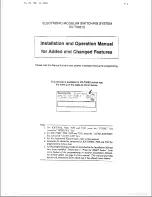
System 10 Portable Camera-Mount Wireless
Installation and Operation
7
For future reference, please record your system information here (the serial number
appear on each transmitter, and on the bottom of each receiver):
Receiver
Model ATW-R1700
Serial Number
Transmitter
Model ATW-T100
Serial Number
1 or 2
System Frequencies
6. Repeat for each additional transmitter. Remember to switch off all
transmitters already paired before adding a new one and to use a
unique ID number for each transmitter.
Note:
With all transmitters turned off, the receiver’s System ID
Display will cycle through all currently paired ID numbers. Turn on
a transmitter to activate its pairing with the receiver. The receiver
recognizes only one transmitter at a time. That transmitter must
be turned off before the receiver will recognize another paired
transmitter. *If that transmitter is turned off out of range, the
receiver will not recognize another paired transmitter until the
receiver is reset by disconnecting the power supply.
Clearing Individual ID Pairings
1. Press the receiver’s System ID button to select the ID number you
wish to clear. The number will begin to blink.
2. Press and hold the Pair and then ID button for about three seconds,
until the display shows a blinking “o.” This indicates that your
selected ID number has been cleared.
3. Release the Pair and ID buttons and, after a few seconds, the
display will stop blinking and return to normal operation.
4. Repeat to clear additional ID pairings.
Clearing All ID Pairings
1. Press and hold the receiver’s Pair and then ID button for about three
seconds, until the display shows a blinking “o.”
2. Release the Pair and ID buttons. Then, within three seconds, press
and hold the Pair and ID buttons again, until the display shows a
blinking “A.” This indicates that all your paired ID numbers have
been cleared.
3. After blinking three seconds, the “A” will change to “-” to indicate
that there are no paired transmitters.
Ten Tips to Obtain the Best Results
1. Use only fresh alkaline or fully charged replaceable batteries for the
transmitter.
2. Position the receiver so that it has the fewest possible obstructions
between it and the normal location of the transmitter. Line-of-sight
is best.
3. The transmitter and the receiver should be as close together as con-
veniently possible, but not less than 6' (2 m).
4. While System 10 has been designed to conveniently mount on
cameras, please keep other wireless devices (including wireless
systems and routers) away from System 10 receivers. For best
performance, some routers and Wi-Fi-based wireless systems may
need to be up to 30 feet away from System 10 receivers.
5. The receiver antennas should be kept away from any metal.
6. Use the transmitter level control to optimize performance for your
sound source.
7. If the receiver output is set too low, the overall signal-to-noise ratio
of the system may be reduced. Conversely, if the Attenuator of the
receiver is set too high, it may over-drive the input of the camera/
mixer, causing distortion. Adjust the output level of the receiver so
the highest sound pressure level going into the camera/mixer causes
no input overload, and yet permits the camera/mixer level controls
to operate in their “normal” range (not set too high or too low). This
provides the optimum signal-to-noise for the entire system.
8. Turn the transmitter off when not in use. Remove the battery if the
transmitter is not to be used for a period of time.
9. Unplug the receiver from the AC outlet when the system is not
in use.
System Operating Frequencies
Automatic Frequency Selection
System 10 wireless systems operate in automatically selected frequen-
cies in the 2.4 GHz range, far from TV and DTV interference. Up to eight
channels may be used together without any frequency coordination
problems or group selection issues. Every time a receiver/transmitter
pair is powered on, it automatically selects clear frequencies. Due to
the dynamic nature of System 10 automatic frequency selection, these
transmitting frequencies may change during power-up or performance if
interference is encountered. These frequency changes occur at both the
receiver and transmitter; they are seamless and imperceptible to the ear.


























